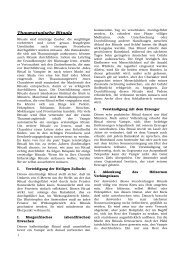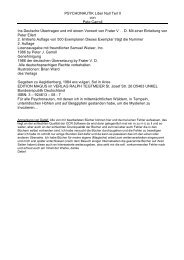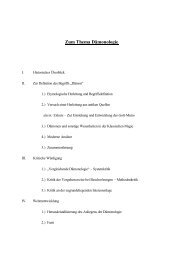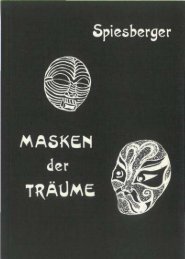CHAPTER 2 CHAPTER 3 CHAPTER 1 CHAPTER 2 CHAPTER 3 ...
CHAPTER 2 CHAPTER 3 CHAPTER 1 CHAPTER 2 CHAPTER 3 ...
CHAPTER 2 CHAPTER 3 CHAPTER 1 CHAPTER 2 CHAPTER 3 ...
You also want an ePaper? Increase the reach of your titles
YUMPU automatically turns print PDFs into web optimized ePapers that Google loves.
<strong>CHAPTER</strong> 4 104<br />
There is a definite increase in telepathic powers when the Lapis stone is used. In experiments, it has been<br />
taped over four gland centers of the sender: Pituitary, Pineal, Thyroids, and Thymus.<br />
Again the Cayce readings say: "It has been given that the Lapis Lingua is the name which was applied to<br />
touchstones, or those used by initiates in their various ceremonial activities. (Hence the stones acquired power<br />
through thought projections about them.) Those that are of a psychic turn may hear the emanations as retained<br />
or thrown off by influence about such stones; the Lapis Lingua would bring much that will act as a protective<br />
influence. This is the green stone, you see, the crystallization of copper and those influences that are creative<br />
within themselves. For, as indicated from the influence of the Lapis Lingua, there is the need for not only the<br />
copper ore, that is a part of man's own development in many fields, but the need for the very combination of<br />
its elements as protection to not only the material benefits but the bodily forces necessary for the transmission<br />
of benefits through its own physical being. Wearing of the Lapis Lingua will make the body more sensitive to<br />
the higher vibrations. The wearing of the Lapis stone would be an aid in the entity's periods of meditation, and<br />
would become a helpful influence. Not as a 'lucky' charm, but rather as a helpful influence toward making for<br />
the ability to make decisions in dealing with mental attributes; the emanations from Lapis Lingua are very<br />
strong. As to stone, have near yourself, worn preferably upon the body, about the neck, the Lapis; this<br />
preferably encased in crystal."<br />
The Cayce readings advised the use of both Lapis Lingua and Lapis Lazuli. The latter was a favorite stone of<br />
the ancient Egyptians. Lapis is probably the sapphire of the old testament and of the ancient writers. Both<br />
Pliny and the Holy Bible make allusions to sapphires as stones sprinkled with gold.<br />
"The stones of it are the place of sapphires: and it hath dust of gold." (Job 28:6).<br />
In certain drawings, ancient personages are shown with a slender band around their head in the center of<br />
which appears a gem or stone of some kind. It is believed that this stone was the Lapis Lingua, and that it is<br />
used not merely for ornamentation but to stimulate the pineal gland near the center of the forehead.<br />
All of the foregoing reference to the Lapis Lingua only shows more clearly the unusual qualities of copper and<br />
why it is used in crystalline form in the construction of the "fireballs".<br />
Copper is the only metal which occurs native abundantly in large masses and copper is supreme among the<br />
common metals in its everlasting qualities. The following are two slightly different forms in which the ancient<br />
alchemists of the Middle Ages employed the "ankh", the symbol of enduring life,<br />
to designate copper. These alchemists always represented copper by the astrological sign for Venus. this circle<br />
with cross attached below was the Egyptian symbol for everlasting or enduring life.<br />
The "ankh" or Crux Ansata symbolized life itself, therefore it was a fitting symbol to be used for copper<br />
which can be the bridge between time and timelessness! Both the cross and the circle were phallic symbols,<br />
for the ancient world venerated the generative powers of Nature as being expressive of the creative attributes<br />
of the Deity. The Crux Ansata, by combining the masculine Tau with the feminine oval, exemplified the<br />
principles of generation. The generative powers which the "ankh" symbolized were also representative of life,<br />
since without these powers no man would be born on Earth.<br />
In Asia, copper was the metal of the Queen of Heaven (Astarte, etc.). As stated before, astrologers and<br />
alchemists assigned it to Venus; it was sacred to the Fire God and the Seven Gods of Babylonia and Assyria;<br />
North Pacific Coast Indians and several other groups assigned it to the Sun; in India it was a sacred metal; the<br />
Indians of the Lake Superior region regarded the lumps of copper they found as divinities.<br />
In some places there is a custom of placing copper on a corpse. This is because copper was symbolic of life.<br />
Pliny mentions that in Arcadia the yew tree is fatal to anyone sleeping under it unless a copper nail is driven






